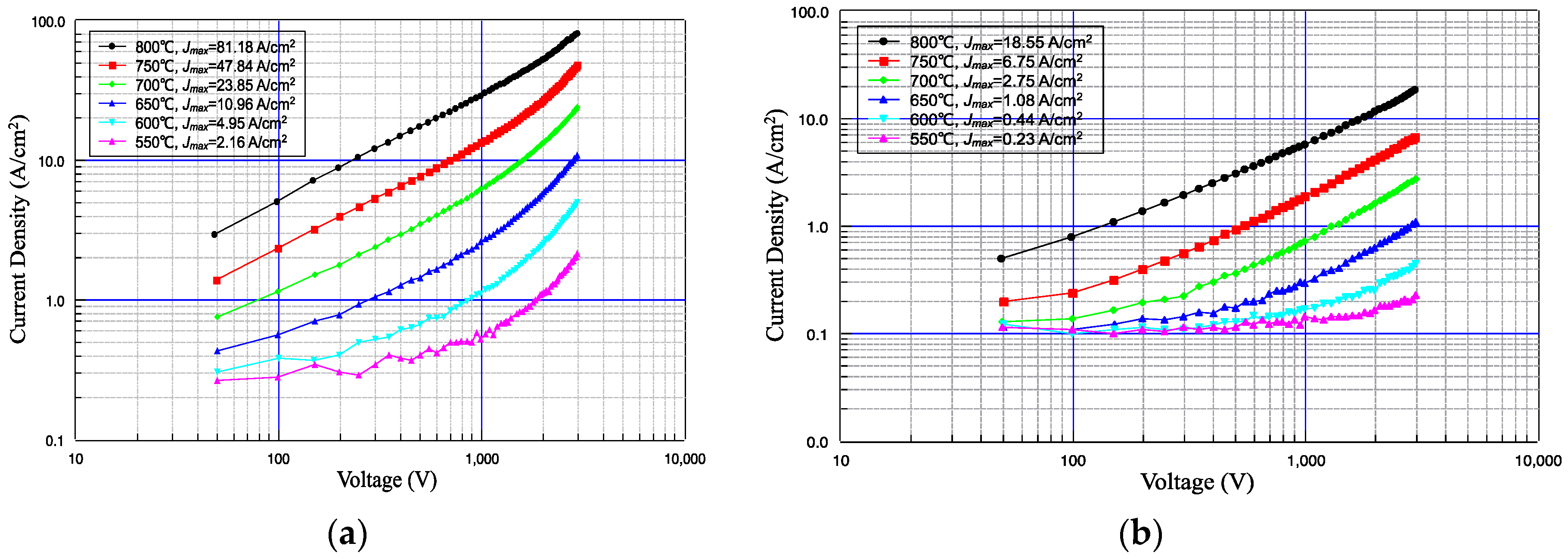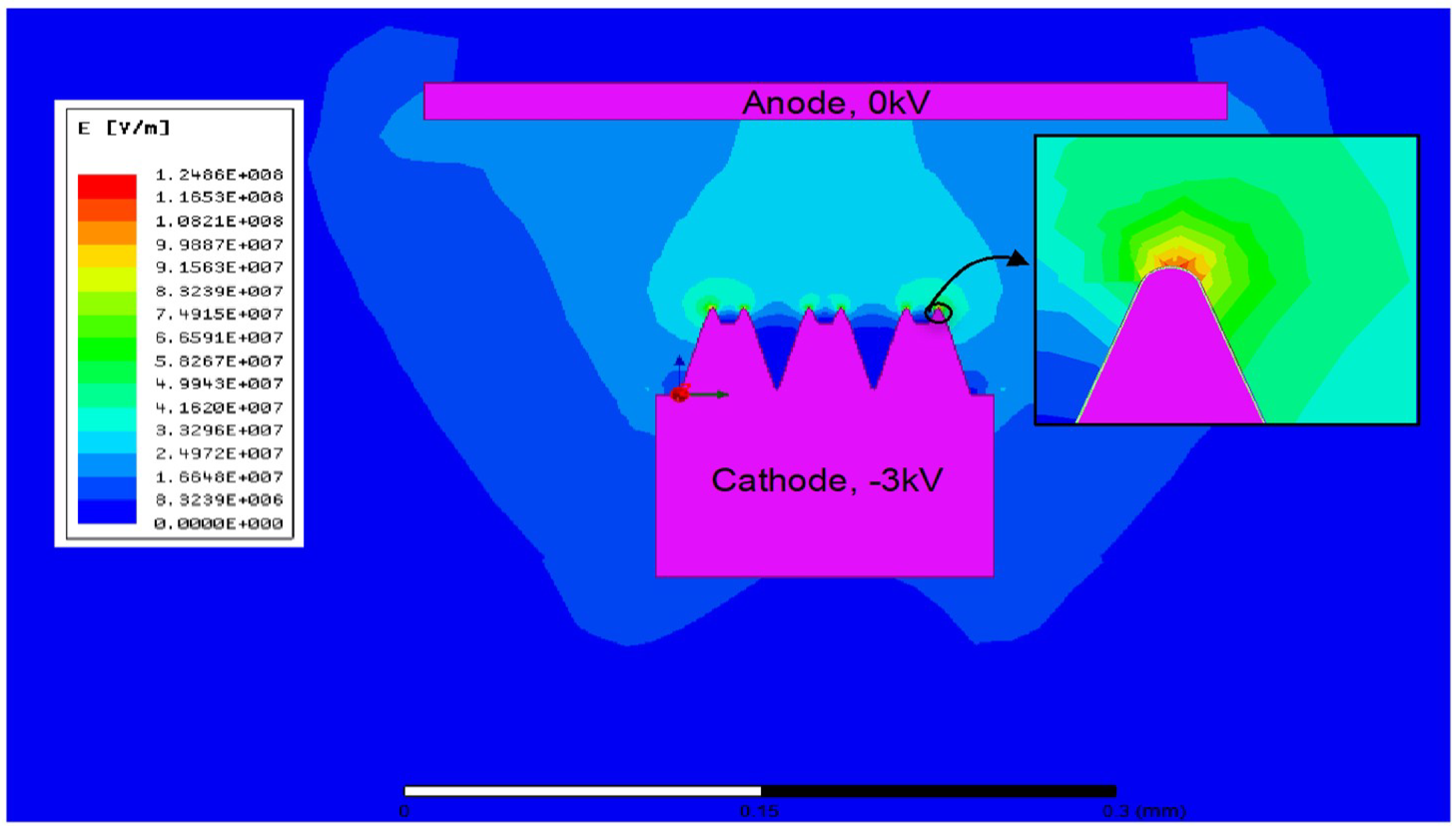Study on Low-Temperature Emission Performance of Scandate Cathode with Micro-Blade-Type Arrays
Abstract
:1. Introduction
2. Experiment
2.1. Fabrication of Micro-Blade-Type Arrays on Porous Tungsten Matrix Surface
2.2. Cathode Preparation
2.3. Characterization of Cathode Morphology and Performance Test
3. Results
3.1. Morphology of Porous Tungsten Micro-Blade-Type Arrays
3.2. Results of the Electron Emission Measurements
4. Discussion and Analysis
4.1. Formation of Micro-Blade-Type Arrays
4.2. Field Enhancement Effect Micro-Blade-Type Arrays
4.3. Emission Characteristics of Scandate Cathode with Micro-Blade-Type Arrays
4.4. Analysis of High Emission Characteristics of Scandate Cathode with Micro-Blade-Type Arrays
5. Conclusions
- An arrangement of micro-blade-type arrays was fabricated well by laser engraving technologies. The micro-blade-type arrays had a height of 20–40 µm and were separated with a spacing of 40 µm. Most of the pores in the tungsten sponge were preserved during the process, which is of importance to the prepared cathode. Simulation results using the Maxwell 2D software showed that the highest electric intensity at the micro-blades was enhanced by four times and reached 1.2 × 108 V/m.
- The prepared cathode exhibited excellent electron emission levels at low temperatures. According to an analysis of the characteristics of the prepared cathode and TEEM images of a scandate cathode, it was considered that the emission type of scandate cathodes is a kind of joint thermal-field emission, similar to a thermal Schottky cathode. A lower work function layer of Ba–Sc–O was formed and retained by heating the cathode, which was in favor of field emission. With the combined effect of heating in a certain range of temperatures and the high electric field intensity generated by the fabricated micro-blades, the electron emission of the prepared cathode was greatly improved.
- The semiconductor model was introduced to specifically analyze the influence of electric strength on electron emission. The calculated result indicates that emission density increased greatly with electric field enhancement. The analysis supports the experimental results, where the prepared scandate cathode with micro-blade-type arrays obtained excellent electron emission performance.
- With the excellent emission performance at relatively low temperature, the proposed cathode has a certain advantage in high-frequency and terahertz VED applications. On the other hand, the fabrication of micro-blade-type arrays may cause the problem of emission uniformity. Work concerning the evaluation and application of the cathode will be carried out in the next step of our research.
Author Contributions
Funding
Conflicts of Interest
References
- Herrmann, G.; Wagener, S. Physics including thermal emission from metals and semi-conductors. In The Oxide-Coated Cathode; Chapman and Hall: London, UK, 1951; p. 190. [Google Scholar]
- Zalm, P.; Van Stratum, A.J.A. Osmium Dispenser Cathodes. Philips Tech. Rev. 1966, 27, 69–75. [Google Scholar]
- Van Stratum, A.J.A.; Van Os, J.G.; Blatter, J.R.; Zalm, P. Barium-Aluminum-Scandate Dispenser Cathode. U.S. Patent 4007393, 8 February 1977. [Google Scholar]
- Kirkwood, D.M.; Gross, S.J.; Balk, T.J.; Beck, M.J.; Booske, J.; Busbaher, D.; Jacobs, R.; Kordesch, M.E.; Mitsdarffer, B.; Morgan, D.; et al. Frontiers in Thermionic Cathode Research. IEEE Trans. Electron Devices 2018, 65, 2061–2071. [Google Scholar] [CrossRef]
- Armstrong, C.M. The quest for the ultimate vacuum tube. IEEE Spectr. 2015, 52, 28–51. [Google Scholar] [CrossRef]
- Pagonakis, I.G.; Gantenbein, G.; Jelonnek, J.; Jin, J.; Illy, S.; Kern, S.; Piosczyk, B.; Rzesnicki, T.; Thumm, M.; Avramides, K.A. Design of the EU-1MW gyrotron for ITER. In Proceedings of the Vacuum Electronics Conference, Paris, France, 21–23 May 2013; pp. 1–2. [Google Scholar]
- Wen-Long, L.; Yi-Man, W.; Wei, L.; Hong-Yi, L.; Jin-Shu, W. Study of mini-themionic electron sources for vacuum electron THz devices. Acta Phys. Sin. 2014, 63, 057901. [Google Scholar]
- Microsystems Technology Office. Broad Agency Announ-cement; DARPA-BAA-15-40; Innovative Vacuum Electronics Science and Technology; Microsystems Technology Office: Arlington, VA, USA, 2015. [Google Scholar]
- Wang, J.; Wang, Y.; Tao, S.; Li, H.; Yang, J.; Zhou, M. Scandia-doped tungsten bodies for Sc-type cathodes. Appl. Surf. Sci. 2003, 215, 38–48. [Google Scholar] [CrossRef]
- Jinshu, W.; Yanchun, W.; Wei, L.; Hongyi, L.; Meiling, Z. Scandia doped tungsten matrix for impregnated cathode. Rare Met. 2008, 27, 9–12. [Google Scholar]
- Wang, J.; Cui, Y.; Liu, W.; Wang, Y.; Yang, F.; Zhou, F.; Zhou, M. A Study of Scandia-Doped-Impregnated Cathode Fabricated by Spray Drying Method. IEEE Trans. Electron Devices 2015, 62, 1635–1640. [Google Scholar] [CrossRef]
- Wang, J.; Lai, C.; Liu, W.; Yang, F.; Zhang, X.; Cui, Y.; Zhou, M. Effect of scandia doping method on the emission uniformity of scandate cathode with Sc2O3-W matrix. Mater. Res. Bull. 2013, 48, 3594–3600. [Google Scholar] [CrossRef]
- Wang, J.; Yang, Y.; Wang, Y.; Liu, W.; Zhou, M.; Zuo, T. A review on scandia doped tungsten matrix scandate cathode. Tungsten 2019, 1, 91. [Google Scholar] [CrossRef] [Green Version]
- Yin, S.; Zhang, Z.; Peng, Z.; Zheng, Q.; Wang, Y. A New Impregnated Dispenser Cathode. IEEE Trans. Electron Devices 2013, 60, 4258–4262. [Google Scholar] [CrossRef]
- Li, N.; Luhmann, N.C.; Gamzina, D.; Soekland, G.; Banducci, M.; Gonzalez, M. Study on the compositions of emission active materials and the emission properties of dispenser cathodes made from Scandia-doped powders. Adv. Powder Technol. 2016, 27, 1933–1940. [Google Scholar] [CrossRef]
- Gärtner, G.; Geittner, P.; Lydtin, H.; Ritz, A. Emission properties of top-layer scandate cathodes prepared by LAD. Appl. Surf. Sci. 1997, 111, 11–17. [Google Scholar] [CrossRef]
- Zhang, X.; Wang, J.; Liu, W.; Tian, T.; Zhou, M. Preparation of W-Sc2O3 targets and scandate cathodes with film prepared by pulsed laser deposition. Mater. Res. Bull. 2013, 48, 5040–5044. [Google Scholar] [CrossRef]
- Peng, Z.; Shengyi, Y.; Qiang, Z.; Xinxin, W.; Yu, W.; Yang, L. Emission Performance of Scandate Cathodes Prepared by Pulse Laser Deposition. J. Electron. Inf. Technol. 2014, 36, 754. [Google Scholar]
- Spindt, C.A.; Holland, C.E.; Stowell, R.D. Field emission cathode array development for high-current-density applications. Appl. Surf. Sci. 1983, 16, 268–276. [Google Scholar] [CrossRef]
- Spindt, C.; Holland, C.E.; Schwoebel, P.R. 11.1: A reliable improved Spindt cathode design for high currents. In Proceedings of the 2010 IEEE International Vacuum Electronics Conference (IVEC), Monterey, CA, USA, 18–20 May 2010; pp. 201–202. [Google Scholar]
- Guerrera, S.A.; Akinwande, A.I. Silicon Field Emitter Arrays With Current Densities Exceeding 100 A/cm2 at Gate Voltages Below 75 V. IEEE Electron Device Lett. 2016, 37, 96–99. [Google Scholar] [CrossRef] [Green Version]
- Mousa, M.S.; Kelly, T.F. Stabilization of carbon-fiber cold field-emission cathodes with a dielectric coating. Ultramicroscopy 2003, 95, 125–130. [Google Scholar] [CrossRef]
- Mousa, M.S.; Kelly, T.F. Characteristics of carbon-fibre cold field emission tips with a dielectric coating. Surf. Interface Anal. 2004, 36, 444–448. [Google Scholar] [CrossRef]
- ImageJ Software. Available online: https://imagej.net/ImageJ (accessed on 5 November 2019).
- Mittal, G.; Lahiri, I. Recent progress in nanostructured next-generation field emission devices. J. Phys. D Appl. Phys. 2014, 47, 323001. [Google Scholar] [CrossRef]
- Harris, J.R.; Jensen, K.L.; Shiffler, D.A.; Petillo, J.J. Shielding in ungated field emitter arrays. Appl. Phys. Lett. 2015, 106, 201603. [Google Scholar] [CrossRef]
- Rudra, R.; Biswas, D. Verification of shielding effect predictions for large area field emitters. AIP Adv. 2019, 9, 125207. [Google Scholar] [CrossRef] [Green Version]
- True, R. Electron Beam Formation, Focusing, and Collection in Microwave Tubes. In Handbook of Microwave Technology: Components and Devices; Academic Press: San Diego, CA, USA, 1995; Volume 1, pp. 497–567. [Google Scholar]
- Van Oostrom, A.; Augustus, L. Activation and early life of a pressed barium scandate cathode. Appl. Surf. Sci. 1979, 2, 173–186. [Google Scholar] [CrossRef]
- Li, J.; Wang, H.; Yu, Z.; Gao, Y. Emission Mechanism of High Current Density Thermionic Cathodes. In Proceedings of the Vacuum Electronics Conference, Kitakyushu, Japan, 15–17 May 2007; pp. 1–2. [Google Scholar]
- Raju, R.S.; Maloney, C.E. Characterization of an impregnated scandate cathode using a semiconductor model. IEEE Trans. Electron Devices 1994, 41, 2460–2467. [Google Scholar] [CrossRef]
- Wang, Y.; Wang, J.; Liu, W.; Li, L.; Wang, Y.; Zhang, X. Correlation between Emission Behavior and Surface Features of Scandate Cathodes. IEEE Trans. Electron Devices 2009, 56, 776–785. [Google Scholar] [CrossRef]
- Yin, S.; Ren, F.; Lu, Z.; Zhang, Y.; Zhang, S.; Yang, F.; Wei, D.; Han, J.; Li, Y. Study on Electron Emission Phenomenon of the Surface Micro Area of Coated Impregnated Dispenser Cathode. J. Electron. Inf. Technol. 2018, 40, 2535–2540. [Google Scholar]
- Wang, Y.; Wang, J.; Liu, W.; Zhang, K.; Li, J. Development of high current-density cathodes with scandia-doped tungsten powders. IEEE Trans. Electron Devices 2007, 54, 1061–1070. [Google Scholar] [CrossRef]
- Zhang, X.; Wang, J.; Wang, Y.; Liu, W.; Zhou, M.; Gao, Z. Investigation of Influence of Surface Nanoparticle on Emission Properties of Scandia-Doped Dispenser Cathodes. Funct. Mater. Lett. 2013, 6, 1350040. [Google Scholar] [CrossRef]
- Swanson, L.W.; Martin, N.A. Field electron cathode stability studies: Zirconium/tungsten thermal-field cathode. J. Appl. Phys. 1975, 46, 2029–2050. [Google Scholar] [CrossRef]
- Swanson, L.; Schwind, G. Review of ZrO/W Schottky Cathode. In Handbook of Charged Particle Optics, 2nd ed.; Orloff, J., Ed.; Taylor and Francis Group: Boca Raton, FL, USA, 2008; pp. 1–28. [Google Scholar]
- Iida, S.; Nagatomi, T.; Takai, Y. Self-recovery function of p(1×1)-Sc-O/W(100) system used as Schottky emitter. Surf. Interface Anal. 2005, 37, 106–109. [Google Scholar] [CrossRef]
- Wright, D.A.; Woods, J. The Emission from Oxide-coated Cathodes in an Accelerating Field. Proc. Phys. Soc. 1952, 65, 134. [Google Scholar] [CrossRef]





| Slope | 800 °C | 750 °C | 700 °C | 650 °C | 600 °C | 550 °C |
|---|---|---|---|---|---|---|
| Slope at low field | 0.75 | 0.77 | 0.76 | 0.69 | 0.55 | 0.34 |
| Slope at high field | 1.03 | 1.34 | 1.37 | 1.50 | 1.57 | 1.48 |
© 2019 by the authors. Licensee MDPI, Basel, Switzerland. This article is an open access article distributed under the terms and conditions of the Creative Commons Attribution (CC BY) license (http://creativecommons.org/licenses/by/4.0/).
Share and Cite
Lu, Z.; Yin, S.; Zhang, Z.; Ren, F.; Lv, X. Study on Low-Temperature Emission Performance of Scandate Cathode with Micro-Blade-Type Arrays. Materials 2020, 13, 100. https://doi.org/10.3390/ma13010100
Lu Z, Yin S, Zhang Z, Ren F, Lv X. Study on Low-Temperature Emission Performance of Scandate Cathode with Micro-Blade-Type Arrays. Materials. 2020; 13(1):100. https://doi.org/10.3390/ma13010100
Chicago/Turabian StyleLu, Zhipeng, Shengyi Yin, Zhaochuan Zhang, Feng Ren, and Xinping Lv. 2020. "Study on Low-Temperature Emission Performance of Scandate Cathode with Micro-Blade-Type Arrays" Materials 13, no. 1: 100. https://doi.org/10.3390/ma13010100





